Determination of the Electricity Storage Power and Capacity for Cooperation with the Microgrid Implementing the Peak Shaving Strategy in Selected Industrial Enterprises
Abstract
:1. Introduction
2. Examined BESS Work Strategies, Characteristics of Companies Selected for Research, and the Adopted BESS Model
2.1. Mathematical Model of BESS Simulation in a Microgrid System
2.2. Assumptions Made in the Simulation Process
- (a)
- In order to ensure comparability of results for all simulations, irrespective of the actual tariff group used in the selected undertakings, the same electricity prices and distribution service rates were adopted as those that were in force in 2021 for company A belonging to tariff group B23, together with the assumed capacity fee;
- (b)
- The time series and duration of the individual price components were described for the time zone UTC + 1;
- (c)
- The energy storage facility under investigation was equipped with lithium-ion batteries, which resulted from the highest degree of commercialization of such storage in microgrid applications [24];
- (d)
- The period to examine the effectiveness of the individual strategies was one year;
- (e)
- The conversion efficiency of the charging and discharging cycle was included on the charging side; hence, the charging power was calculated taking into account the power required to cover conversion losses. During the calculations, the efficiency of the conversion system was assumed as 85%;
- (f)
- An arbitrarily maximum depth of discharge was assumed to be ;
- (g)
- It was assumed that the simulation studies would be carried out in the scope of reduction in the contractual capacity, with the initial value equal to 0 and the maximum value of 16 %, with a relative power decrement k equal to 0.55–0.59% of the contractual capacity rounded to 1 kW;
- (h)
- In order to determine the CAPEX costs of the BESS installation (, results from the study [25], which presented the results of BESS price surveys on the US market, were used to assess the peak shaving strategy. Using data taken from this study to determine the price level of individual components, the installation cost was divided into two groups: costs corresponding to the storage capacity, specified in MWh, and costs corresponding to power, expressed in [PLN/MW]. The installation cost model are presented in Table 2.
- (i)
- the annual cost of energy storage device [PLN/year] was defined as the investment cost of an energy storage unit with a lifetime of 15 years, converted into a simple annual rate, i.e., not taking into account the cost of capital and discount rates . Operating costs have also been omitted; = 0, as the costs of operation and inspections are negligible, because the parameters of the BESS are constantly monitored and periodic operation procedures are not performed. The CAPEX operating costs of purchasing electricity for charging were taken into account with the following:
- (j)
- In the tests, contracted power was assumed in the amount of maximum demand for 15-min power in a given year In fact, in an enterprise, due to the variable and to some extent random nature of the contractual capacity, a certain level of reserve capacity is assumed in order to minimize the risk of overruns. In this study, it was assumed that the financial benefit results from the reduction in contractual capacity are equal to the power of the BESS, without considering the level of reserve capacity and the alternative cost of exceeding contractual capacity;
- (k)
- The simulation was performed with the use of MS Excel with “Developer” add-ons installed.
3. BESS Simulation Results for Peak Shaving Functionality in Microgrid Systems
- Option A-ver A (loading as soon as possible ASAP). The size of the BESS capacity corresponds to the amount of energy necessary to cover the highest value of BESS EBPs,tp energy during the billing period. Charging after discharging to reduce the excess in contracted capacity takes place in the next period when it is possible. In this variant, we assume that there is no designated Zc charging zone, and that the energy stored in the BESS can be recharged in each tp interval, should conditions (10) and (12) allow it. For this variant, INCP was marked as BESS income ver A.
- Variant Z-ver Z (zone strategy of charging, i.e., charging only in the designated charging zone Zc). The size of the BESS capacity corresponds to the energy necessary to cover the largest amount of energy accumulated during the billing period, assuming that charging takes place only during the charging zone. In this variant, we assume that the stored energy of the BESS is accumulated not only for consecutive exceedances, but additionally for exceedances occurring in the periods between charging zones. For this variant, INCP was denoted as BESS income ver Z.
4. Summary and Conclusions
Limitations of This Study, Conclusions, and Proposals for Further Research
- Regarding the peak shaving strategy, further research is recommended to more accurately identify the characteristic point opt.2, which defines the local limitations related to the nature of the electric power demand profile.
- Research on the impact of variability in energy demand time series and analyses to determine the predictability of the maximum values of the average 15-min power could be used to estimate the risk when determining the BESS parameters for the functionalities tested.
- In the simulations presented, no analyses of the problem of instantaneous discharge currents in the interval in which the exceedance occurs were performed. In the simulation, it was assumed that the power required to reduce the exceedance is the same throughout the entire interval, and is calculated after the end of a given 15-min period. In fact, the discharge system to reduce the overrun should have an overrun size prediction function based on additional frequency response power readings over the 15-min interval under investigation. In this way, the instantaneous discharge powers can be adjusted in order to keep the average 15-min power drawn from the grid to an appropriate level. Testing the exceedance prediction function that allows one to select the instantaneous power quantity to reduce the exceedance may constitute an additional area of research.
- In order to optimize the size of the BESS, further work may consider the introduction of a charging power limitation, which would reduce the BESS costs related to the power of the inverters. However, a reduction in charging power may make it necessary to increase the BESS capacity in order to ensure the necessary system readiness for peak shaving strategies.
- It is worth conducting further research on the profitability of peak shaving functionality in cases where the exceedances occur individually during the day and result from the predictable nature of production. These studies should answer the question of which characteristic features of demand waveforms most affect the profitability of the BESS operation for the reduction in contracted capacity. These characteristic features of the time series of demand are as follows: the multiplicity and frequency of exceedances, grouping of exceedances, profile variability, values describing the regression curve, distinguishing cyclic components, etc.
- The study carried out simulations aimed at determining the power and BESS capacity for peak shaving functionality. However, it is worth undertaking further research on the possibility of obtaining synergistic effects of various strategies working together. Further research may also be important to combine functionalities, taking into account their allocation to separate markets, i.e., the electricity market, which is the domain of companies dealing in electricity trading, and the capacity market that is representative of distribution and transmission system operators.
- Although currently the implementation of the peak shaving strategy is unprofitable to apply BESS solely in a microgrid, this functionality may be of fundamental importance for the power system. The peak power control mechanisms described in this paper may allow the grid operator to provide grid flexibility services such as frequency regulation, voltage regulation, and DSR (Demand Side Response). These functionalities will allow one to generate additional revenue streams from BESS applications in order to implement the peak shaving strategy for the entrepreneur. At the same time, they will affect the safety of the operation of public power networks, despite the growing number of unstable renewable energy sources that require loads, such as fast car chargers.
Author Contributions
Funding
Institutional Review Board Statement
Informed Consent Statement
Data Availability Statement
Conflicts of Interest
Nomenclature
| Index | Description | Unit |
| y | Year index | |
| tp | 15-min interval | |
| tpo | 15-min interval during which the contractual capacity was exceeded. | |
| k | System state for the set value of the contractual power | |
| Charge power, 15-min average | kW | |
| Charge power, 15-min average in the interval of exceeding the contractual power. | kW | |
| PU | Contractual power | kW |
| Power of reduce contractual power | kW | |
| i | Sum of variable rates for electricity distribution services for the time zone in the tpo and tpc intervals | PLN/kWh |
| SS | Fixed rate for electricity distribution services | PLN/kW/m |
| SSP | Fixed rate of the transitional fee | PLN/kW/m |
| Operating cost of load power | PLN | |
| OE | BESS operating cost of purchasing electricity for charging | PLN |
| , | Electricity price accordingly for the zone in the intervals and tpc | PLN/kWh |
| BESS revenue resulting from the change contractual power | PLN | |
| BESS revenue resulting from the avoided purchase of electricity from the DSO grid | PLN | |
| BESS income from peak shaving | PLN | |
| PBP | BESS power for peak shaving strategy | kW |
| BESS discharge power for the compensation of exceeding the contractual power in the interval | kW | |
| BESS charging power in the interval | kW | |
| BESS capacity for peak shaving strategy | kWh | |
| Energy stored in the BESS for the peak shaving strategy in the interval | kWh | |
| BESS discharge energy for the compensation of exceeding the contractual power in the interval | kWh | |
| BESS charging energy in the 15-min interval | kWh | |
| Designated charging time zone (charge zone) | ||
| Number of contractual power settlement periods | ||
| Nominal BESS efficiency for charging and discharging cycle | % | |
| DoDp | Maximum discharge depth of discharge for peak shaving | % |
| DoDmax | Depth of discharge | % |
| Total cost of BESS | PLN | |
| Total BESS cost per year | PLN | |
| L | BESS lifetime | years |
| Weighted average cost of capital | ||
| Discount rate | ||
| Annual maintenance cost | PLN/year | |
| BESS capital cost | PLN | |
| BESS capital costs dependent on power | PLN/kW | |
| BESS capital costs dependent on capacity | PLN/KWh |
References
- Jamali, A.A.; Nor, N.M.; Ibrahim, T. Energy storage systems and their sizing techniques in power system—A review. In Proceedings of the 2015 IEEE Conference on Energy Conversion (CENCON), Johor Bahru, Malaysia, 19–20 October 2015; pp. 215–220, ISBN 978-1-4799-8598-2/15. [Google Scholar] [CrossRef]
- Ross, M.; Hidalgo, R.; Abbey, C.; Joós, G. Analysis of Energy Storage Sizing and Technologies. In Proceedings of the 2010 IEEE Electrical Power & Energy Conference, Halifax, NS, Canada, 25–27 August 2010. [Google Scholar] [CrossRef]
- Paska, J.; Kłos, M. Magazynowanie Energii Elektrycznej—Technologie, Zastosowania, Koszty, POLITECHNIKA WARSZAWSKA Instytut Elektroenergetyki Zakład Elektrowni i Gospodarki Elektroenergetycznej, Portal Polskiego Instytutu Magazynowania E Energii. Available online: https://orka.sejm.gov.pl/opinie8.nsf/nazwa/363_20161019_1/$file/363_20161019_1.pdf (accessed on 17 November 2016).
- Jayashree, S.; Malarvizhi, K. Methodologies for Optimal Sizing of Battery Energy Storage in Microgrids: A Comprehensive Review. In Proceedings of the 2020 International Conference on Computer Communication and Informatics (ICCCI-2020), Coimbatore, India, 22–24 January 2020. [Google Scholar] [CrossRef]
- Faisal, M.; Hannan, M.A.; Ker, P.J.; Hussain, A.; Mansor, M.B.; Blaabjerg, F. Review of Energy Storage System Technologies in Microgrid Applications: Issues and Challenges. Special Section on Advanced Energy Storage Technologies and Their Applications; IEEE Access: Piscataway, NJ, USA, 2018; pp. 35143–35164. [Google Scholar] [CrossRef]
- Kharseh, M.; Wallbaum, H. How Adding a Battery to Grid-Connected Photovoltaic System Can Increases Its Economic Performance: Compare Different Scenarios. Preprints 2018, 2018, 110616. [Google Scholar] [CrossRef]
- Beaudin, M.; Zareipour, H.; Schellenberglabe, A.; Rosehart, W. Energy storage for mitigating the variability of renewable electricity sources: An updated review. Energy Sustain. Dev. 2010, 14, 302–314. [Google Scholar] [CrossRef]
- Delfino, F.; Procopio, R.; Rossi, M.; Brignone, M.; Robba, M.; Bracco, S. Microgrid Design and Operation: Toward Smart Energy in Cities; Artech House: London, UK, 2018; ISBN 978-1-63081-150-1. [Google Scholar]
- Tseng, S.; Li, J.; Lee, M.; Wang, B.; Ji, F.; Bai, B. A software defined energy storage: Architecture, topology, and reliability. In Proceedings of the 2017 China International Electrical and Energy Conference (CIEEC), Beijing, China, 25–27 October 2017; pp. 737–741. [Google Scholar] [CrossRef]
- Mongird, K.; Viswanathan, V.V.; Balducci, P.J.; Alam MJ, E.; Fotedar, V.; Koritarov, V.S.; Hadjerioua, B. Energy Storage Technology and Cost Characterization Report; Pacific Northwest National Laboratory, Argonne National Laboratory, Oak Ridge National Laboratory, supported by the HydroWIRES Initiative of DOE’s Water Power Technologies Office (WPTO); Pacific Northwest National Lab.(PNNL): Richland, WA, USA, 2019. [Google Scholar] [CrossRef]
- Opathella, C.; Elkasrawy, A.; Mohamed, A.A.; Venkatesh, B. A Novel Capacity Market Model with Energy Storage. IEEE Trans. Smart Grid 2019, 10, 5283–5293. [Google Scholar] [CrossRef]
- Zablocki, A. Fact Sheet|Energy Storage, EESI, 22 February 2019. Available online: https://www.eesi.org/papers/view/energy-storage-2019 (accessed on 10 November 2021).
- Olabi, A.G. Renewable energy and energy storage systems. Energy 2017, 136, 1–6. [Google Scholar] [CrossRef]
- Behabtu, H.A.; Messagie, M.; Coosemans, T.; Berecibar, M.; Fante, K.A.; Kebede, A.A.; van Mierlo, J. A Review of Energy Storage Technologies. Application Potentials in Renewable Energy Sources. Grid Integration. Sustainability 2020, 12, 10511. [Google Scholar] [CrossRef]
- Alharbi, H.; Bhattacharya, K. Stochastic Optimal Planning of Battery Energy Storage Systems for Isolated Microgrids. IEEE Trans. Sustain. Energy 2018, 9, 211–227. [Google Scholar] [CrossRef]
- Bahramirad, S.; Daneshi, H. Optimal Sizing of Smart Grid Storage Management System in a Microgrid. In Proceedings of the 2012 IEEE PES Innovative Smart Grid Technologies (ISGT), Washington, DC, USA, 16–20 January 2012. [Google Scholar] [CrossRef]
- Barcellona, S.; Piegari, L.; Tironi, E.; Musolino, V. A Methodology for a Correct Sizing of Electrochemical Storage Devices. In Proceedings of the 2015 IEEE PES Asia-Pacific Power and Energy Engineering Conference (APPEEC), Brisbane, Australia, 15–18 November 2015. [Google Scholar] [CrossRef]
- Nanewortor, X.; Janik, P.; Waclawek, Z.; Leonowicz, Z. Optimal Sizing of Renewable Energy Plant–Storage System for Network Support. In Proceedings of the 2016 IEEE 16th International Conference on Environment and Electrical Engineering, Florence, Italy, 7–10 June 2016; ISBN 978-1-5090-2320-2/16. [Google Scholar] [CrossRef]
- Alsaidan, I.; Khodaei, A.; Gao, W. A Comprehensive Battery Energy Storage Optimal Sizing Model for Microgrid Applications. Trans. Power Syst. 2018, 33, 3968–3980. [Google Scholar] [CrossRef]
- Dong, J.; Gao, F.; Guan, X.; Zhai, Q.; Wu, J. Storage Sizing with Peak-Shaving Policy for Wind Farm Based on Cyclic Markov Chain Model. IEEE Trans. Sustain. Energy 2017, 8, 978–989. [Google Scholar] [CrossRef]
- Baker, K.; Hug, G.; Li, X. Energy Storage Sizing Taking into Account Forecast Uncertainties and Receding Horizon Operation. IEEE Trans. Sustain. Energy 2016, 8, 331–340. [Google Scholar] [CrossRef]
- Ke, X.; Lu, N.; Jin, C. Control and Size Energy Storage for Managing Energy balance of Variable Generation Resources. In Proceedings of the 2014 IEEE PES General Meeting/Conference & Exposition, National Harbor, MD, USA, 27–31 July 2014. [Google Scholar] [CrossRef]
- Ma, T.; Lashway, C.R.; Song, Y.; Mohammed, O. Optimal Renewable Energy Farm and Energy Storage Sizing Method for Future Hybrid Power System. In Proceedings of the 17th International Conference on Electrical Machines and Systems (ICEMS), Hangzhou, China, 22–25 October 2014; pp. 2827–2832. [Google Scholar] [CrossRef]
- Zhang, J.; Guo, D.; Shanxi, F.W.; Zuo, Y.; Zhang, H. Research on Energy Management Strategy for Islanded Microgrid Based on Hybrid Storage Device. In Proceedings of the International Conference on Renewable Energy Research and Applications, Madrid, Spain, 20–23 October 2013; ISBN 978-4799-1464-7/13. [Google Scholar] [CrossRef]
- Dhabi, A. The International Renewable Energy Agency (IRENA): Electricity Storage and Renewables, Costs and Markets to 2030. October 2017. Available online: https://www.irena.org/publications/2017/oct/electricity-storage-and-renewables-costs-and-markets (accessed on 10 November 2021).
- Barnes, F.S.; Levine, J.G. Large Energy Storage Systems Handbook; Taylor & Francis Inc.: Oxfordshire, UK, 2011; ISBN 978-1-4200-8601-0. [Google Scholar] [CrossRef]
- Amrouche, S.O.; Rekioua, D.; Rekioua, T.; Bacha, S. Overview of energy storage in renewable energy systems. Int. J. Hydrog. Energy 2016, 41, 20914–20927. [Google Scholar] [CrossRef]
- Rahmann, C.; Mac-Clure, B.; Vittal, V.; Valencia, F. Break-Even Points of Battery Energy Storage Systems for Peak Shaving Applications. Energies 2017, 10, 833. [Google Scholar] [CrossRef]
- Yang, Y.; Li, H. Performance analysis of LiFePO4 battery energy storage for utility-scale PV system. In Proceedings of the 2014 IEEE Energy Conversion Congress and Exposition (ECCE), Pittsburgh, PA, USA, 14–18 September 2014; pp. 414–419. [Google Scholar] [CrossRef]
- Moseley, P.T.; Garche, J. Electrochemical Energy Storage for Renewable Sources and Grid Balancing; Elsevier Science: Amsterdam, The Netherlands, 2014; ISBN 9780444626103. Available online: https://www.researchgate.net/publication/291249437_Electrochemical_Energy_Storage_for_Renewable_Sources_and_Grid_Balancing (accessed on 10 November 2021).
- Li, J.; Chen, B.; Zhou, J.; Mo, Y. The optimal planning of wind power capacity and energy storage capacity based on the bilinear interpolation theory. In Smart Power Distribution Systems; Academic Press: Cambridge, MA, USA, 2019; pp. 411–445. [Google Scholar] [CrossRef]
- Ganesan, S.; Subramaniam, U.; Ghodke, A.A.; Elavarasan, R.M.; Raju, K.; Bhaskar, M.S. Investigation on Sizing of Voltage Source for a Battery Energy Storage System in Microgrid with Renewable Energy Sources. IEEE Access 2020, 8, 188861–188874. [Google Scholar] [CrossRef]
- Evans, A.; Strezov, V.; Evans, T.J. Assessment of utility energy storage options for increased renewable energy penetration. Renew. Sustain. Energy Rev. 2012, 16, 4141–4147. [Google Scholar] [CrossRef]
- Naidu, B.R.; Panda, G.; Babu, B.C. Dynamic energy management and control of a grid-interactive DC microgrid system. In Smart Power Distribution Systems Control, Communication, and Optimization; Academic Press: Cambridge, MA, USA, 2019; pp. 41–67. [Google Scholar] [CrossRef]
- Bayram, I.S.; Abdallah, M.; Tajer, A.; Qaraqe, K. Energy Storage Sizing for Peak Hour Utility Applications. In Proceedings of the2015 IEEE International Conference on Communications (ICC), London, UK, 8–12 June 2015; pp. 770–775, ISBN 978-1-4673-6432-4/15. [Google Scholar] [CrossRef]
- Chudy, D.; Leśniak, A.; Łódzka, P.; Elektroenergetyki, I. Wykorzystanie Magazynowania Energii w Celu Optymalizacji Kosztów Zasilania Zakładu Przemysłowego, Energia Gigawat. 11 December 2020. Available online: https://gigawat.info/artykul/items/wykorzystanie-magazynowania-energii-w-celu-optymalizacji-kosztow-zasilania-zakladu-przemyslowego.html (accessed on 10 November 2021).
- Martins, R.; Hesse, H.C.; Jungbauer, J.; Vorbuchner, T.; Musilek, P. Optimal Component Sizing for Peak Shaving in Battery Energy Storage System for Industrial Applications. Energies 2018, 11, 2048. [Google Scholar] [CrossRef] [Green Version]
- Gao, N.; Lin, X.; Wu, W.; Blaabje, F. Grid Current Feedback Active Damping Control Based on Disturbance Observer for Battery Energy Storage Power Conversion System with LCL Filter. Energies 2021, 14, 1482. [Google Scholar] [CrossRef]
- Kwon, S.; Xu, Y.; Gautam, N. Meeting Inelastic Demand in Systems With Storage and Renewable Sources. IEEE Trans. Smart Grid 2017, 8, 1619–1629. [Google Scholar] [CrossRef]
- Sadeghi, A.; Torbaghan, S.S.; Gibescu, M. Benefits of Clearing Capacity Markets in Short Term Horizon: The Case of Germany. In Proceedings of the 2018 15th International Conference on the European Energy Market (EEM), Stockholm, Sweden, 27–29 June 2018; pp. 1–5. [Google Scholar] [CrossRef]
- Siface, D. Optimal Sizing of a BESS Providing Multiple Services to the System: A Stochastic Approach. In Proceedings of the 2020 17th International Conference on the European Energy Market (EEM), Stockholm, Sweden, 16–18 September 2020; pp. 1–5. [Google Scholar] [CrossRef]
- Ge, Y.; Ye, H.; Loparo, K.A. Agent-Based Privacy Preserving Transactive Control for Managing Peak Power Consumption. IEEE Trans. Smart Grid 2020, 11, 4883–4890. [Google Scholar] [CrossRef]
- Regulation to the Energy Act Rozporządzenie Ministra Energii z dnia 6 Marca 2019 r. w Sprawie Szczegółowych Zasad Kształtowania i Kalkulacji Taryf Oraz Rozliczeń w Obrocie Energią Elektryczną; Climate and Environment Ministry: Wawelska, Poland, 2019.
- The Act of Energy Low in Poland April 10, 1997.
- Regulation to the Energy Act Rozporządzenie Ministra Klimatu I Środowiska z dnia 9 Listopada 2020 r. w Sprawie Pobierania Opłaty Mocowej i Wyznaczania Godzin Doby Przypadających na Szczytowe Zapotrzebowanie na moc w Systemie; Climate and Environment Ministry: Wawelska, Poland, 2020.
- Rotella Junior, P.; Rocha, L.C.S.; Morioka, S.N.; Bolis, I.; Chicco, G.; Mazza, A.; Janda, K. Economic Analysis of the Investments in Battery Energy Storage Systems: Review and Current Perspectives. Energies 2021, 14, 2503. [Google Scholar] [CrossRef]
- Ertugrul, N. Battery Storage Technologies, Applications and Trend in Renewable Energy. In Proceedings of the 2016 IEEE International Conference on Sustainable Energy Technologies (ICSET), Hanoi, Vietnam, 14–16 November 2016; ISBN 978-1-5090-5200-4/16. [Google Scholar] [CrossRef]
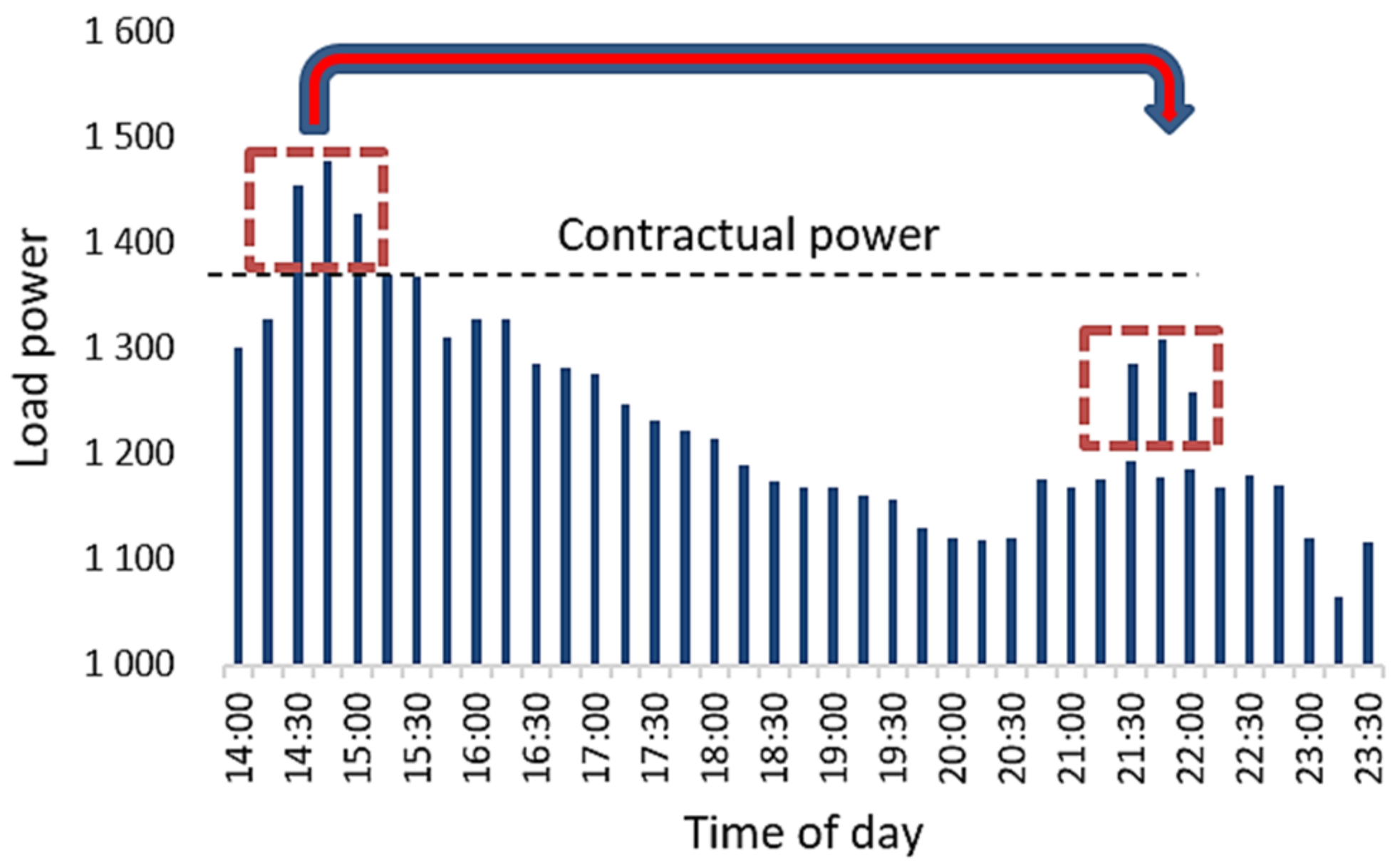




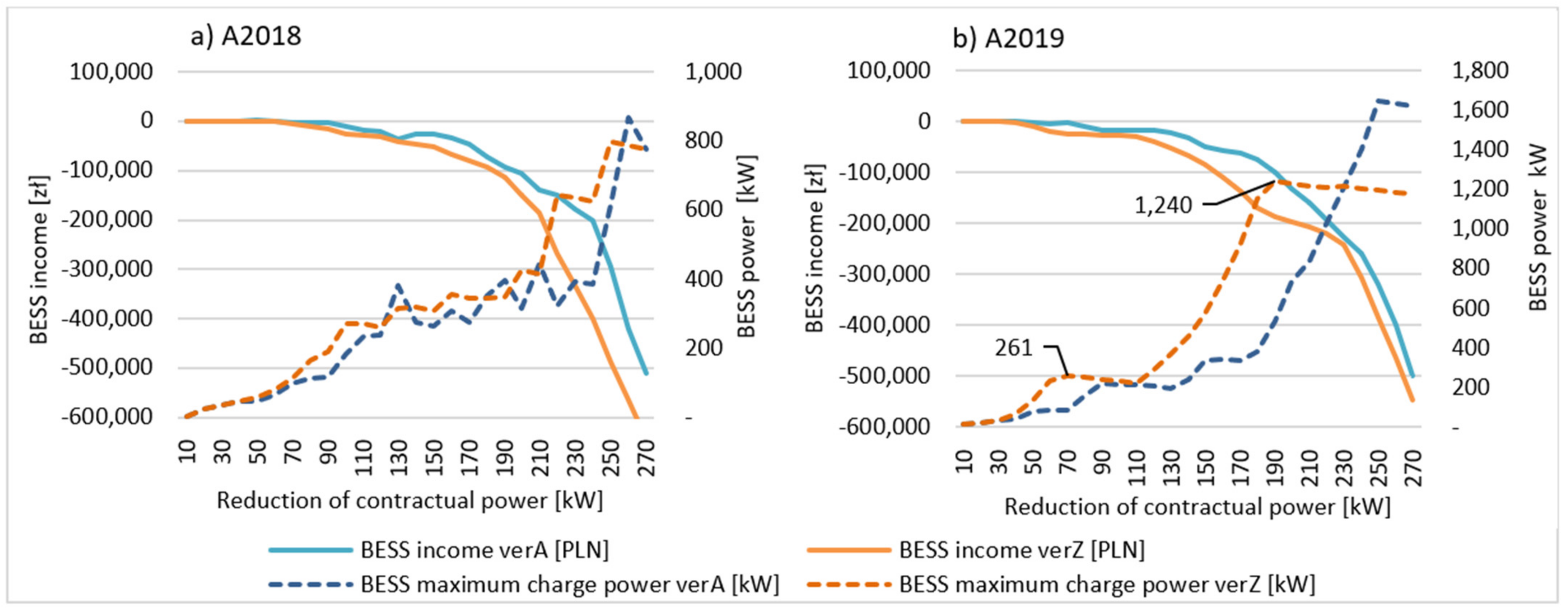
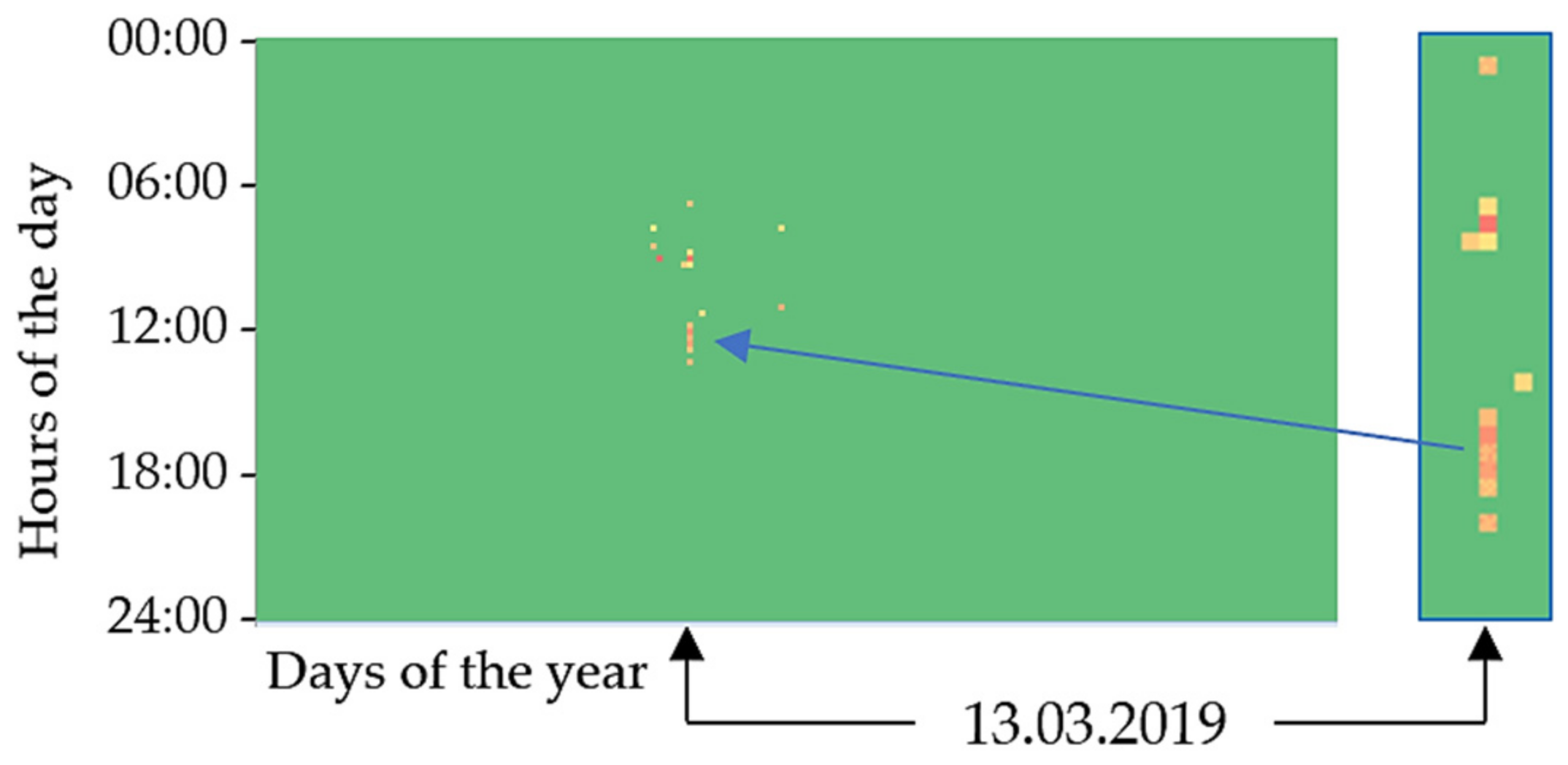
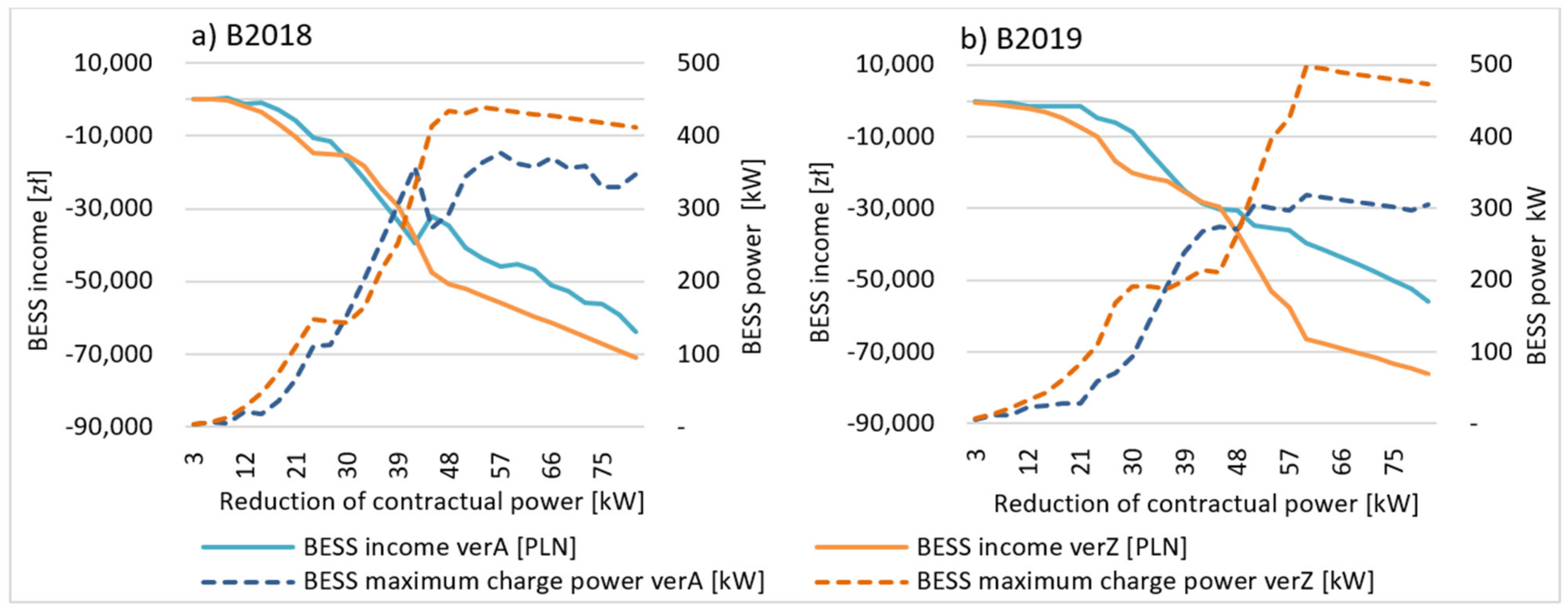
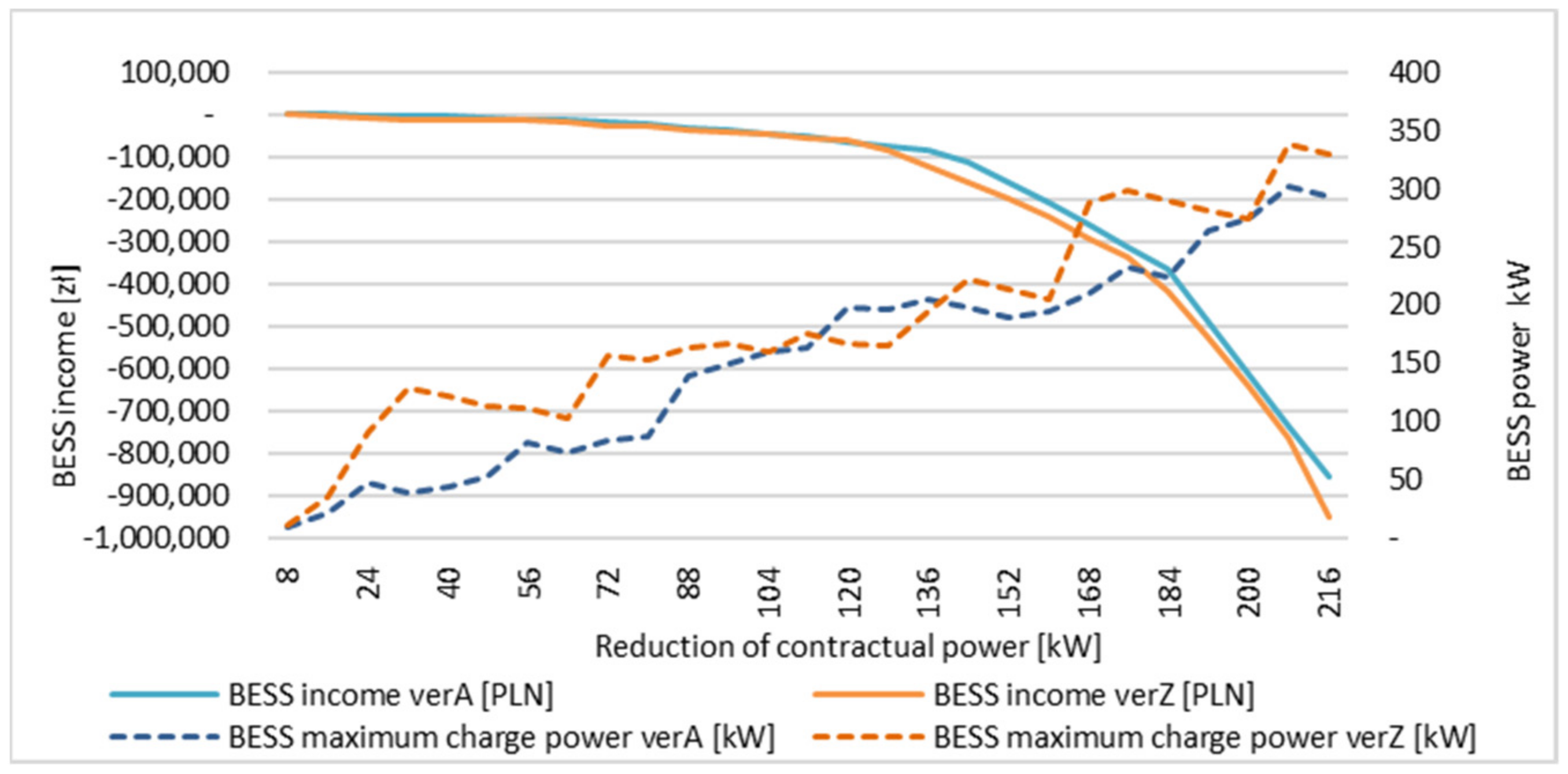
| Enterprise Average 15-min Load Power in Year | A2018 | A2019 | B2018 | B2019 | C2019 | |
|---|---|---|---|---|---|---|
| Maximum | kW | 1822.6 | 1860 | 509 | 508 | 1272 |
| Average | kW | 1217 | 1177 | 208 | 202 | 786 |
| Median | kW | 1336 | 1361 | 228 | 205 | 786 |
| Standard deviation | kW | 353 | 434 | 175 | 174 | 176 |
| Variance | (kW)2 | 124,763 | 187,968 | 30,730 | 30,142 | 30,845 |
| Coefficient of variation | - | 29% | 37% | 84% | 86% | 22% |
| BESS Capital Cost Elements | Unit | Component Cost |
|---|---|---|
| Battery capacity | $/kWh | $271.00 |
| Conversion system (inverters) | $/kW | $288.00 |
| Control system | $/kW | $100.00 |
| Installation and commissioning | $/kWh | $101.00 |
| Summary | ||
| $/kW | $388.00 | |
| $/kWh | $372.00 | |
| Enterprise | Input Parameters | Output Parameters for A2018 and A2019 | ||||||
|---|---|---|---|---|---|---|---|---|
| Reduction in Contractual Power [kW] | % of Contractual Power PU [%] | BESS Maximum Discharge Power [kW] | BESS Maximum Charge Power [kW] | BESS Capacity [kWh] | BESS Income/Loss [PLN] | |||
| opt.1 | verA | A2018 | 50 | 2.7 | 50 | 46 | 16 | 1501 |
| A2019 | 40 | 2.2 | 40 | 68 | 13 | 943 | ||
| verZ | A2018 | 50 | 2.7 | 50 | 58 | 16 | 258 | |
| A2019 | 30 | 1.6 | 30 | 35 | 8 | 117 | ||
| opt.2 | verZ | A2018 | 120 | 6.6 | 120 | 262 | 257 | −32,044 |
| A2019 | 100 | 5.5 | 100 | 231 | 203 | −26,935 | ||
| verA | A2018 | 150 | 8.2 | 150 | 264 | 246 | −27,004 | |
| A2019 | 120 | 6.6 | 120 | 205 | 151 | −16,051 | ||
| Enterprise | Input Parameters | Output Parameters for B2018 and B2018 | ||||||
|---|---|---|---|---|---|---|---|---|
| Reduction in Contractual Power [kW] | % of Contractual Power PU [%] | BESS Maximum Discharge Power [kW] | BESS Maximum Charge Power [kW] | BESS Capacity [kWh] | BESS Income/Loss [PLN] | |||
| opt.1 | verA | B2018 | 9 | 1.8 | 9 | 6 | 3 | 459 |
| B2019 | 0 | 0 | 0 | 0 | 0 | 0 | ||
| verZ | B2018 | 6 | 1.2 | 6 | 7 | 2 | 35 | |
| B2019 | 0 | 0 | 0 | 0 | 0 | 0 | ||
Publisher’s Note: MDPI stays neutral with regard to jurisdictional claims in published maps and institutional affiliations. |
© 2022 by the authors. Licensee MDPI, Basel, Switzerland. This article is an open access article distributed under the terms and conditions of the Creative Commons Attribution (CC BY) license (https://creativecommons.org/licenses/by/4.0/).
Share and Cite
Kuźniak, R.; Pawelec, A.; Bartosik, A.; Pawełczyk, M. Determination of the Electricity Storage Power and Capacity for Cooperation with the Microgrid Implementing the Peak Shaving Strategy in Selected Industrial Enterprises. Energies 2022, 15, 4793. https://doi.org/10.3390/en15134793
Kuźniak R, Pawelec A, Bartosik A, Pawełczyk M. Determination of the Electricity Storage Power and Capacity for Cooperation with the Microgrid Implementing the Peak Shaving Strategy in Selected Industrial Enterprises. Energies. 2022; 15(13):4793. https://doi.org/10.3390/en15134793
Chicago/Turabian StyleKuźniak, Rafał, Artur Pawelec, Artur Bartosik, and Marek Pawełczyk. 2022. "Determination of the Electricity Storage Power and Capacity for Cooperation with the Microgrid Implementing the Peak Shaving Strategy in Selected Industrial Enterprises" Energies 15, no. 13: 4793. https://doi.org/10.3390/en15134793
APA StyleKuźniak, R., Pawelec, A., Bartosik, A., & Pawełczyk, M. (2022). Determination of the Electricity Storage Power and Capacity for Cooperation with the Microgrid Implementing the Peak Shaving Strategy in Selected Industrial Enterprises. Energies, 15(13), 4793. https://doi.org/10.3390/en15134793







